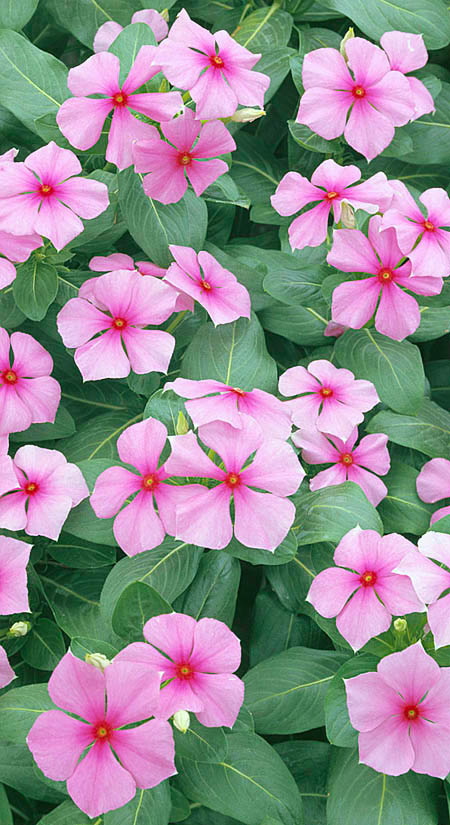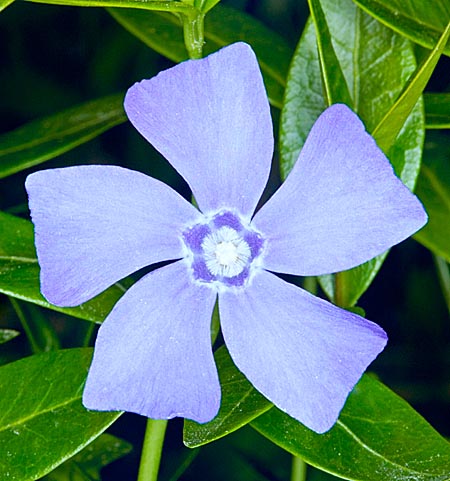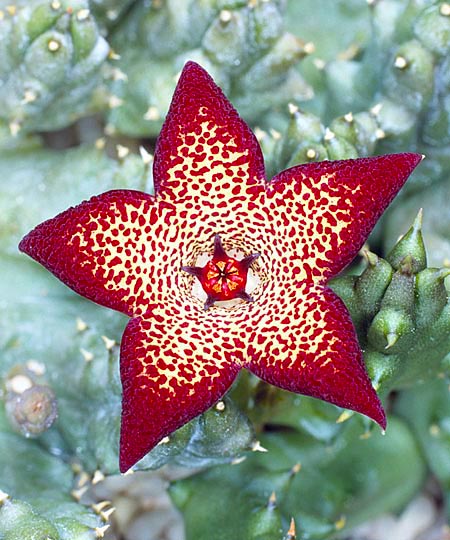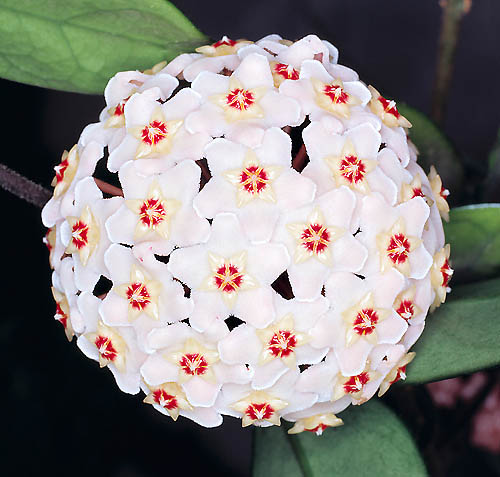
Text © Giuseppe Mazza

English translation by Ignacio Barrionuevo

Catharanthus roseus © Giuseppe Mazza
Apocynaceae is an important family of flowering plants present in every tropical and subtropical region in the world, with a clear predilection for rainforests, and some species that grow in temperate climates, such as Vinca minor common even in Italy up to the submontane forests.
This family contains approximately 5.600 species including perennials, herbaceous and succulent species, shrubs and trees such as Alstonia angustiloba which can grow over 40 m high, or Alstonia pneumatophora that bears a record at 85 m.
The family includes species that often grow in swamps, like the aforementioned trees, but in arid zones too, like Adenium obesum or even in the limits of the desert, such as the genera Huernia, Orbea, Orbeopsis, Piaranthus, Stapelia, Tridentea and Caralluma formerly a part of the family Asclepiadaceae.
Plants that also find their home in the Mediterranean region, such as the Oleander (Nerium oleander), which spontaneously grows in the riverbeds and is famous for its toxicity, given that the Apocynaceae, in order to defend themselves from the attack of the herbivores, are able to produce powerful poisons. This fact is well known by some butterflies and beetles which accumulate this substances day after day inside their tissues, associating them with distinctive liveries to avoid being preyed upon.
Strophanthus gratus seeds served, a while ago, to poison arrows and caused immediate cardiac arrest; but, now, proven that only the dose makes a poison, many Apocynaceae are considered medicinal plants: Strophanthus preussii, for instance, heals the heart, Catharanthus roseus helps with the leukaemia and Ochrosia elliptica shows promising antitumor properties.
From another point of view we find the decorative interests. Thanks to the beauty and perfume of its flowers, the Frangipani or Temple Tree (Plumeria rubra, Allamanda cathartica, Odontadenia macrantha, Cascabela thevetioides, Thevetia peruviana, Cryptostegia grandiflora and others can be found in every tropical and subtropical gardens, whereas the splendid Mandevilla boliviensis, where the climate is more adverse, is cultivated as a summer annual. The vigorous and very scented Trachelospermum jasminoides can resist even -12 ºC and, sheltered by a window, the Hoya carnosa cheers and scents during the night the houses in Northern Europe.
The typical structure of the flower, which is hermaphrodite and actinomorphic, shows a calyx with 5 sepals more or less fused towards the base, and an infundibuliform corolla with 5 petals equally fused towards the base, and a corona with its typical appendices protecting the gynoecium. The androecium has 5 stamens and the gynoecium is formed by 2-5 fused carpels forming a superior or semi-inferior ovary.

Vinca minor © Giuseppe Mazza
The pollination is performed by insects that sometimes are loaded, like in the case of the orchids, with large pollen masses. The fruits can be capsules, berries, follicles or drupes with seeds that often show structures prepared for anemochorous dispersal.
This family currently (2015) comprises the following genera:
Absolmsia, Acokanthera, Adelostemma, Adenium, Aganonerion, Aganosma, Alafia, Allamanda, Allomarkgrafia, Allowoodsonia, Alstonia, Alyxia, Amalocalyx, Ambelania, Ampelamus, Amphineurion, Amsonia, Anatropanthus, Ancylobothrys, Anechites, Angadenia, Angolluma, Anisopus, Anisotoma, Anodendron, Apocynum, Araujia, Artia, Asclepias, Asketanthera, Aspidoglossum, Aspidonepsis, Aspidosperma, Astephanus, Asterostemma, Atherandra, Atherolepis, Baeolepis, Baharuia, Bahiella, Baissea, Ballyanthus, Barjonia, Baroniella, Baseonema, Batesanthus, Baynesia, Beaumontia, Biondia, Blepharodon, Blyttia, Bousigonia, Brachystelma, Buckollia, Calathostelma, Callichilia, Calocrater, Calostigma, Calotropis, Calyptranthera, Cameraria, Campestigma, Camptocarpus, Caralluma, Carissa, Carruthersia, Carvalhoa, Cascabela, Catharanthus, Cerbera, Cerberiopsis, Ceropegia, Chamaeclitandra, Chilocarpus, Chlorocyathus, Chonemorpha, Cibirhiza, Cionura, Cleghornia, Clitandra, Condylocarpon, Conomitra, Cordylogyne, Corollonema, Cosmostigma, Couma, Craspidospermum, Crioceras, Cryptolepis, Cryptostegia, Cyathostelma, Cycladenia, Cyclocotyla, Cylindropsis, Cynanchum, Dactylostelma, Dalzielia, Decalepis, Decanema, Decastelma, Desmidorchis, Dewevrella, Dictyanthus, Dictyophleba, Diplolepis, Diplorhynchus, Diplostigma, Dischidanthus, Dischidia, Dischidiopsis, Ditassa, Dittoceras, Dolichopetalum, Dregea, Duvalia, Duvaliandra, Dyera, Echidnopsis, Echites, Ecliptostelma, Ectadium,

Tridentea jucunda © Giuseppe Mazza
Ecua, Edithcolea, Elytropus, Emicocarpus, Emplectanthus, Ephippiocarpa, Epigynum, Epistemma, Eucorymbia, Eustegia, Fanninia, Farquharia, Fernaldia, Finlaysonia, Fischeria, Fockea, Forsteronia, Frerea, Funastrum, Funtumia, Galactophora, Geissospermum, Genianthus, Glossonema, Glossostelma, Gomphocarpus, Gongronema, Gonioma, Goniostemma, Gonocrypta, Gonolobus, Gonostemon, Goydera, Graphistemma, Gunnessia, Gymnanthera, Gymnema, Gymnemopsis, Hancornia, Hanghomia, Haplophyton, Hemidesmus, Hemipogon, Heterostemma, Hiepia, Himatanthus, Holarrhena, Holostemma, Hoodia, Hoodiopsis, Hoya, Huernia, Huerniopsis, Hunteria, Hybanthera, Hylaea, Hypolobus, Ichnocarpus, Ischnolepis, Ischnostemma, Isonema, Ixodonerium, Jasminanthes, Jobinia, Kamettia, Kanahia, Kerbera, Kibatalia, Kopsia, Krebsia, Lacmellea, Lagarinthus, Landolphia, Laubertia, Lavrania, Laxoplumeria, Leachiella, Leichardtia, Lepinia, Lepiniopsis, Leptadenia, Leuconotis, Luckhoffia, Lygisma, Maclaudia, Macoubea, Macroditassa, Macropharynx, Macroscepis, Malouetia, Mandevilla, Mangenotia, Manothrix, Margaretta, Marsdenia, Mascarenhasia, Matelea, Melinia, Mellichampia, Melodinus, Merrillanthus, Mesechites, Metalepis, Metaplexis, Metastelma, Micholitzia, Micrechites, Microdactylon, Microloma, Microplumeria, Minaria, Miraglossum, Mitostigma, Molongum, Mondia, Monolluma, Morrenia, Mortoniella, Motandra, Mucoa, Myriopteron, Nanostelma, Nautonia, Neobracea, Neocouma, Neoschumannia, Nephradenia, Nerium, Notechidnopsis, Ochrosia, Odontadenia, Odontanthera, Odontostephana, Omphalogonus, Oncinema, Oncinotis, Oncostemma, Ophionella, Orbea, Orbeanthus, Orbeopsis, Orthanthera, Orthopichonia, Orthosia, Oxypetalum, Oxystelma, Pachycarpus, Pachycymbium, Pachypodium, Pacouria, Pala, Papuechites, Parahancornia, Parameria, Parapodium, Parepigynum, Parsonsia, Pectinaria, Peltastes, Pentacyphus, Pentalinon, Pentarrhinum, Pentasachme, Pentastelma, Pentatropis, Pentopetia, Peplonia, Pergularia, Periglossum, Periploca, Pervillaea,

Hoya carnosa © Giuseppe Mazza
Petalostelma, Petchia, Petopentia, Pezisicarpus, Pherotrichis, Philibertia, Phyllanthera, Physostelma, Piaranthus, Picralima, Pinochia, Plectaneia, Pleiocarpa, Pleioceras, Pleurostelma, Plumeria, Polystemma, Pottsia, Prestonia, Pseudibatia, Pseudolithos, Pseudopectinaria, Pteralyxia, Pycnobotrya, Quaqua, Quisumbingia, Raphionacme, Raphistemma, Rauvolfia, Rhabdadenia, Rhazya, Rhigospira, Rhyncharrhena, Rhyssolobium, Rhyssostelma, Rhytidocaulon, Riocreuxia, Rojasia, Saba, Sacleuxia, Sarcolobus, Sarcorrhiza, Sarcostemma, Schistogyne, Schistonema, Schizoglossum, Schizostephanus, Schizozygia, Schlechterella, Schubertia, Secamone, Secamonopsis, Secondatia, Seutera, Sichuania, Sindechites, Sinomarsdenia, Sisyranthus, Skytanthus, Solenostemma, Sphaerocodon, Spirolobium, Spongiosperma, Stapelia, Stapelianthus, Stapeliopsis, Stathmostelma, Stenomeria, Stenostelma, Stephanostegia, Stephanostema, Stephanotis, Stigmatorhynchus, Stipecoma, Stomatostemma, Strempeliopsis, Streptocaulon, Strophanthus, Tabernaemontana, Tabernanthe, Tacazzea, Tassadia, Tavaresia, Telminostelma, Telosma, Temnadenia, Tenaris, Tetraphysa, Thenardia, Thevetia, Thoreauea, Thyrsanthella, Tintinnabularia, Tonduzia, Toxocarpus, Trachelospermum, Trichocaulon, Trichosacme, Tridentea, Triodoglossum, Triplosperma, Tromotriche, Tweedia, Tylophora, Tylophoropsis, Urceola, Vahadenia, Vallariopsis, Vallaris, Vallesia, Vinca, Vincetoxicum, Voacanga, Widgrenia, Willughbeia, Woodia, Wrightia, Xysmalobium.
→ To appreciate the biodiversity within the APOCYNACEAE family please click here.
